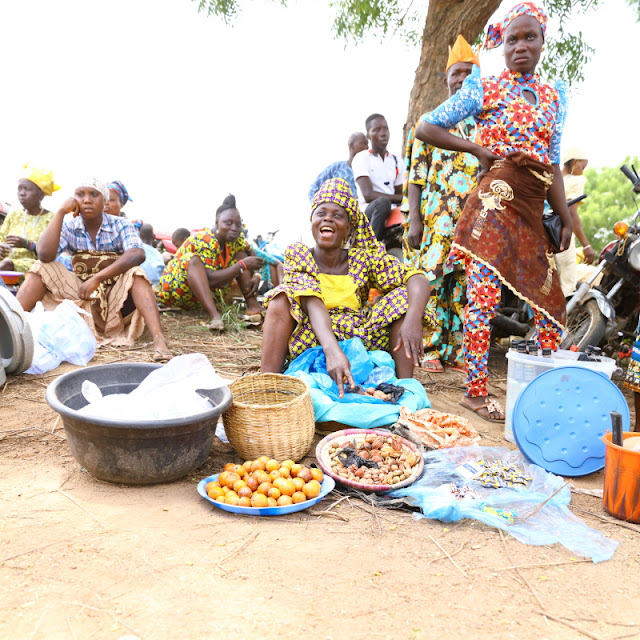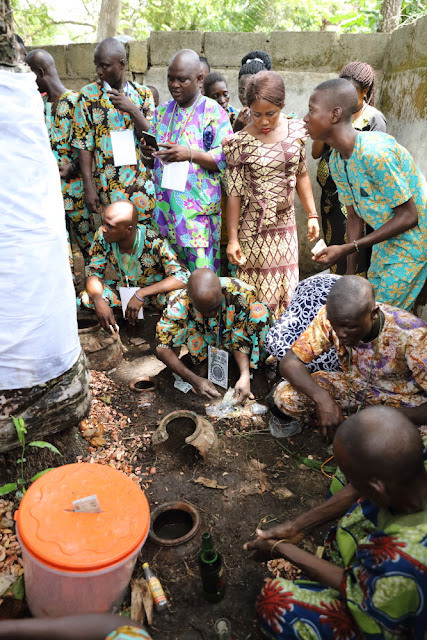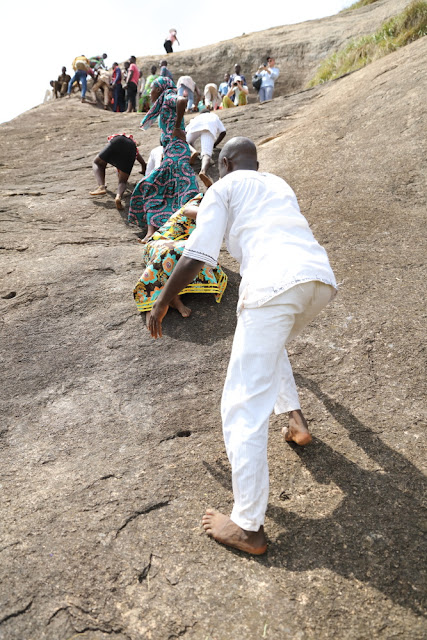 |
| walking to the Agidan Hill |
Oke Agidan (Agidan hill) is located near Oyo town. It is a
dome-shaped rock which dominates the flat land around it. The land belongs to
the Alaafin of Oyo and for a while it was not permitted to cultivate it.
Nowadays things are changing and the rock is surrounded by fields of cassava
and yam. Fortunately, a few trees remain standing and give the landscape some
allure. The rock itself is host to several shrines dedicated to various yoruba
divinities.
Once a year, around April, a large pilgrimage takes place. The
starting point of the pilgrimage is a grove where multiple tents have been
erected to offer pilgrims food, drinks and ritual items such as kola nuts, bitter-kola
nuts, some plastic beads bracelets (almond green and brown) or Ifa chains (mix of
nuts and beads) for divination.
 |
| Oya, buy my nuts! |
Pilgrims are coming all the way from Oyo town on motorbikes,
mini-buses, cars, some possibly walk. Drums are providing rhythm to the place.
An eclectic crowd of devotees were wearing their best attire on the occasion, all
more colourful than the other. Style is de rigueur. The Youth is adopting less
traditional outfits in a quest to look like successful Nigerian rappers living
in Florida or worst case in Lagos: imported second-hand t-shirt with carefully
chosen slogans (play-boy for the boys is a recurring choice) but also less
obvious statements which I am keen to believe have something to do with the
personality of the new owner, golden chains with trinkets, sunglasses, etc...
The most amazing of the youth attires are padded trousers and top: 100% plastic
and surely not the best compromise for hot weather but, we all know that,
looking cool is well worth sweating in the heat!
In the grove, there is a small shrine (an enclosure of
10*10m approximately) in the middle of which grows a specific palm tree called “ope”. Before starting the walk to the rock, it is customary to go and pray at the shrine. There is a long queue to enter the narrow space but everyone is
generally in a good mood (there are always VIPs that need to be attended first
and everyone knows that).
 |
| Ifa divination before getting started |
Inside the shrine, dedicated to Orunmila, about 10 or 15 Ifa
priests, identifiable by the label hanging around their neck, are helping
with the blessing ceremony (kola nut offering together with money to get a good
omen). The place is as lively as a bookmaker booth a few minutes before the
Grand Prix d'Amerique (most famous horse race in France). Kola nuts are broken,
thrown in the air and sprayed with water in order to see what Olodumare commands.
Then starts a walk towards the Agidan rock, about 500 meters away.
At its foot, there are two shrines (one dedicated to Oke and to other orisas). To climb the bare rock, one has to part with shoes as it is quite
steep in places. About 30 or 40 meters higher is another shrine (Egbe) which is
nested along the rock at the entrance of a narrow cave. The legend says that a
snake is coming out to the pots half buried in the ground where offerings are
made to appease him. After that starts the real climb on the searing hot stone, which
many of us will not complete in full.
 |
| barefoot on the burning stone |
A pilgrimage is a journey, this one leads to the sky, where
silence and peace invite prayers, a step closer to the divine. Devotees are
sitting on the hot stone and pray in the wind. Some will carry kola nuts that
they will open and through in the air, spray them with a bit of water from a
sachet and ready the omens for the year to come. The ascent is challenging and
gives a sense of fulfilment to those who make it all the way up. Coming down over
an easier path is like an afterthought.
I met on the way some people from Cotonou and an Ijebu rasta-student who
was taught at University about the Existentialist movement in France with
authors like Jean Paul Sartre. It was a strange encounter half-way up the rock!
 |
| heavenly reward at the top of Oke Agidan |
Please appease the gods of power and potholes for those of us in lagos who can't travel
ReplyDeleteHere is the secret recipe: Seaman gin and kola nuts, possibly a few nairas for credibility. Hope the gods will be appeased by your appeal
Delete